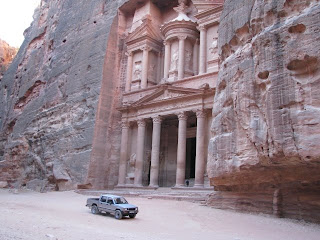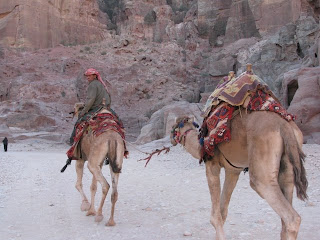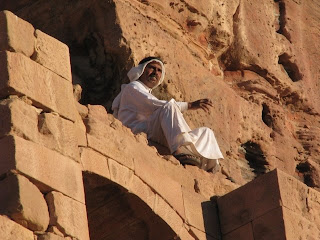The northwestern part of Jordan is the most lush and greenest section of the country. It makes quite a contrast to the desert mountains we passed through on the way down to Petra. Our only adventure on the way was getting "pulled over" by Jordanian traffic police. They do not chase after people in patrol cars, but somehow they identify the cars they wish to stop, and have a partial roadblock set up further up the highway at which they step out and wave the cars down. We were picked out and stopped, but we are not sure for what because when the officer realized we did not speak Arabic, he gave up on trying to communicate whatever it was we were doing wrong. We are lucky we did not get a ticket!
It takes a couple of hours to make it from Madaba to Jerash, but once we got there, we had no trouble finding the archaeological site. It sits directly in the middle of town, beside the highway, surrounded by everything modern in the highly polluted, dirty town of Jerash:

The site itself is fairly spectacular. Of course, we were still buzzing from Petra, and it can't compare to that, but as Roman sites go it is fairly well-preserved. The pollution and fog settling into the hills around the city even made for a picturesque, if not healthy, scene:

The monumental entrance to the ancient city, a gate built in honor of the emperor Hadrian, for whom Gerasa was a favorite city, is quite impressive.

PETER CHECKS OUT HADRIAN'S ARCH

OF COURSE THERE HAS TO BE SCAFFOLDING!
The first thing you see after passing through that arch is the hippodrome for chariot races. During the high season, there are chariot races and Roman military parades put on by costumed actors here a couple of times a day.

CAN YOU BELIEVE THIS IS THE BEST PICTURE WE HAVE OF THE HIPPODROME?

A STREET IN JERASH

PETER TAKES A SEAT
Other excellent sites include the Temple of Artemis, where we came upon a few makeshift stalls of locals selling jewelry and mint tea, which we enjoyed in the shade of the ancient columns alongside the few other tourists who had come that day.

THE TEA SELLERS SET-UP IN THE TEMPLE OF ARTEMIS
The most iconic view of Gerasa is an oval-shaped plaza, unique in the Roman world, surrounded by 160 Ionic columns:

We also went a bit further afield to see the Byzantine Church of St. George, whose remarkable mosaic floors are unfortunately sitting open to the elements, inviting more damage. These floors display excellent example of the "pixellation" of the mosaics by Muslims in later periods (see Holy Land Day 3: On to Jordan).


The most unusual thing that we saw in Gerash was not, however, an ancient monument. We had wandered into the theater, and while we were looking around, a man in a Jordanian military uniform came in with bagpipes and began playing. We were definitely not expecting that!


After a few hours at Gerash, we made the trip back to Amman, to return our rental car and catch the bus back to Israel. On the way we saw an interesting sight. An apparently highly devout Muslim man, prayer time upon him, had pulled his car over to the side of the busy mountain highway, taken out his prayer rug, and was praying on the shoulder of the road, cars whizzing past. Now that is dedication!
We got back to Amman in plenty of time to return our car, or so we thought. We had been given directions back to the rental agency by the agent who gave us our car, but for some reason he thought we would come in from Jerash on a different highway. Since that did not happen, his directions were useless to us. We had a map with us, but could not find a street that was marked with the same name as any streets on the map. We stopped in a McDonald's, where none of the workers could identify where we were on the map. They instructed us to go to a different neighborhood and that maybe someone there would know the area we were looking for. So we drove to another neighborhood, where we stopped at a Burger King. Again, everyone said we were not in the correct neighborhood, and no one could point to where we WERE on a map! But one of the guys behind the counter took pity on us and called the rental agency, who gave us directions through him. We finally made it back to the agency, but with only 20 minutes left to make it to the rendezvous with the bus! One of the men from the rental agency knew where the hotel where the bus originated was, and offered to drive us. We got to within a few dozen yards of the place, but were caught on the wrong side of a very busy divided street and had to drive another half mile until a turnaround, where the traffic light was out and the cop directing traffic (a woman, much to our surprise) was doing a terrible job and not allowing anyone to turn. It was a very nervous twenty minutes, but we finally did make it to the bus with not a moment to spare. All in all, it took us two hours from the time we arrived back in Amman to the time we found the bus. I think we were both about to pass out from the stress! (Again, Peter gets major bonus points for being able to navigate Amman, even though we didn't know where we were going!)
The bus ride back to the Israeli border was uneventful. The only site of note that we passed was Gadara, which sits right on the border of Jordan and Israel, in a very lush valley. This was the site of the miracle that Christ performed in which he caused demons (a group of them, who called themselves Legion) to move from the body of a man they were possessing into a flock of pigs, all 2000 of whom then fled off a cliff edge. (Matt 8:28; Mark 5:1; Luke 8:26).
But when we re-entered Israel, we had an unfortunate incident. The young woman border control agent (very young, perhaps 19) who was checking our passports agreed not to stamp them as we asked. But she then became distracted and "accidentally" stamped my passport. So now any plans to go to Syria in the near future are shattered, since I must either acquire a second passport or wait until the end of this trip and request a new one (my research permissions for the remainder of my time in Turkey are in the current one, so I cannot get rid of it). This was a very frustrating moment for me because we had faced so much questioning during the other four border crossings we had already made, and it was disappointing that just because the young woman was not paying attention, it had all been for nothing and now I will have to go through the lengthy and potentially expensive process of obtaining a new (or second) passport.
But I suppose, all things considered, we should be glad that we made it back from Jordan to Israel that day at all!





















































